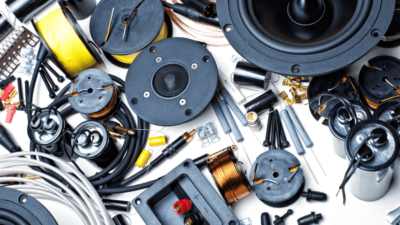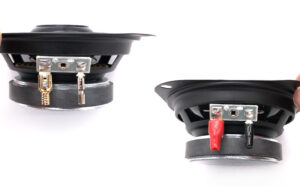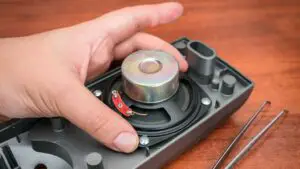Are you tired of experiencing lackluster sound quality from your speakers? One possible culprit could be incorrect speaker polarity. Testing speaker polarity is a simple process that can make a big difference in your audio experience. However, you need to learn how to test speaker polarity to do the right thing.
In this guide, we’ll take you through the step-by-step process of testing speaker polarity, so you can enjoy high-quality sound from your speakers every time.
What is speaker polarity?
Speaker polarity refers to the alignment of the positive and negative terminals on a speaker with the positive and negative terminals on an amplifier or receiver. When the polarity is correct, the speaker cone moves in the correct direction, and the sound waves propagate in the intended manner.
However, when the polarity is reversed, the speaker cone moves in the opposite direction, leading to sound cancellation, loss of bass response, and a generally distorted audio experience.
It is important to test speaker polarity to ensure that the speakers are wired correctly and operating optimally. Proper speaker polarity can improve audio quality, make the sound more accurate and dynamic, and prevent damage to the speakers or other audio equipment.
So, testing speaker polarity is a straightforward process that can be done with a simple test tone and a few basic tools and can greatly enhance your audio experience.
How to determine if your speaker has positive or negative polarity?
To determine if your speaker has positive or negative polarity, you will need a 9-volt battery and a piece of wire.
Here are the steps to follow:
- Disconnect the speaker from the amplifier or receiver.
- Take the 9-volt battery and the wire and strip the ends of the wire.
- Touch the positive terminal of the battery to the positive terminal of the speaker.
- Take the stripped end of the wire and touch it to the negative terminal of the battery.
- Briefly touch the other end of the wire to the negative terminal of the speaker.
- Observe the direction in which the speaker cone moves.
If the speaker cone moves outward, then the positive terminal of the speaker is connected to the positive terminal of the battery. If the speaker cone moves inward, then the positive terminal of the speaker is connected to the negative terminal of the battery.
Once you have determined the polarity of the speaker, mark the positive and negative terminals so you can wire it correctly when you reconnect it to your amplifier or receiver. Repeat the process for each speaker in your system to ensure all of them are wired correctly.
What equipment is needed to test speaker polarity?
Testing speaker polarity is a simple process that requires only a few basic tools. Here’s what you’ll need:
- Test tone generator: You’ll need a source of test tones to send to your speakers. A test tone generator can be a standalone device, an app on your smartphone or computer, or a built-in feature on your amplifier or receiver.
- Multimeter: A multimeter is an electrical test tool that can measure voltage, current, and resistance. You’ll use it to measure the voltage between the positive and negative terminals of the speaker.
- Test leads: You’ll need a set of test leads to connect the multimeter to the speaker terminals.
- Batteries or power supply: You’ll need a 9-volt battery or a power supply to power the test tone generator.
- Wire or alligator clips: You’ll need wire or alligator clips to connect the speaker terminals to the test leads.
With these tools, you’ll be able to generate test tones and measure the voltage between the positive and negative terminals of the speaker to determine its polarity. If you don’t have a multimeter, you can use the battery test method described in the previous answer to determine the speaker polarity.
Can you test speaker polarity with a multimeter?
Yes, you can test speaker polarity with a multimeter. Here are the steps to follow:
- Set your multimeter to measure DC voltage.
- Connect the test leads to the multimeter. Connect the black test lead to the negative (-) socket on the multimeter, and the red test lead to the positive (+) socket.
- Connect the test leads to the speaker. Connect the black test lead to the negative (-) terminal of the speaker, and the red test lead to the positive (+) terminal of the speaker.
- Power on the test tone generator and set it to output a 1 kHz test tone.
- Hold the test leads to the corresponding terminals of the test tone generator. Connect the black test lead to the ground or negative (-) terminal of the generator, and the red test lead to the positive (+) terminal of the generator.
- Place the speaker and the test tone generator a few feet apart. This will prevent the test tone from overwhelming the multimeter.
- Slowly increase the volume of the test tone generator until the multimeter shows a reading of around 1 volt.
- Observe the reading on the multimeter. If the reading is positive, then the speaker’s polarity is correct. If the reading is negative, then the speaker polarity is reversed.
Once you have determined the polarity of the speaker, mark the positive and negative terminals so you can wire it correctly when you reconnect it to your amplifier or receiver. Repeat the process for each speaker in your system to ensure all of them are wired correctly.
How to interpret the results of a speaker polarity test?
The results of a speaker polarity test can be interpreted as follows:
- Positive reading: If the multimeter shows a positive voltage reading when testing speaker polarity, it indicates that the positive terminal of the speaker is connected to the positive terminal of the amplifier or receiver, which is the correct polarity. This means that when the speaker is connected to the amplifier or receiver, the speaker cone will move outward when a positive voltage is applied to it, and the sound waves will propagate in the intended manner.
- Negative reading: If the multimeter shows a negative voltage reading when testing speaker polarity, it indicates that the positive terminal of the speaker is connected to the negative terminal of the amplifier or receiver, which is the reverse polarity. This means that when the speaker is connected to the amplifier or receiver, the speaker cone will move inward when a positive voltage is applied to it, leading to sound cancellation, loss of bass response, and a generally distorted audio experience.
It is important to wire your speakers with the correct polarity to ensure that they are operating optimally and delivering high-quality sound. If you find that the polarity of your speakers is reversed, simply switch the positive and negative wires between the speaker and the amplifier or receiver to correct the polarity.
How to correct reverse polarity in a speaker?
To correct reverse polarity in a speaker, you need to switch the wires connected to the positive and negative terminals of the speaker.
Here are the steps to follow:
- Turn off the amplifier or receiver and disconnect the speaker from it.
- Identify the wires connected to the positive and negative terminals of the speaker.
- Switch the wires so that the one connected to the negative terminal is now connected to the positive terminal and vice versa.
- Reconnect the speaker to the amplifier or receiver.
- Turn on the amplifier or receiver and play some music or a test tone to verify that the polarity is now correct.
- If necessary, use a multimeter or the battery test method to confirm that the polarity is now correct.
- Repeat the process for each speaker in your system to ensure all of them are wired correctly.
It is important to ensure that all of your speakers are wired with the correct polarity to avoid any issues with sound quality or cancellation. By following these steps, you can easily correct the polarity of a reversed speaker and enjoy optimal sound quality from your audio system.
What is the impact of reverse polarity on speaker performance?
Reverse polarity in a speaker can have a significant impact on its performance and sound quality. When a speaker is wired with reversed polarity, the sound waves from the positive and negative terminals of the speaker cone will be out of phase, which can lead to sound cancellation, loss of bass response, and a generally distorted audio experience.
Here are some specific ways that reverse polarity can impact speaker performance:
- Reduced Bass Response: The reversed polarity can cause the speaker to move in a direction opposite to the intended direction, resulting in less bass response and reduced overall volume.
- Sound Cancellation: When the sound waves from the positive and negative terminals of the speaker cone are out of phase, they can cancel each other out. This leads to a decrease in the overall volume and quality of the sound.
- Poor Imaging and Soundstage: Reverse polarity can also lead to poor imaging and soundstage. Soundstage refers to the width and depth of the sound image in front of the listener. With reverse polarity, the stereo image can become narrower, making it more difficult to distinguish between instruments and vocals.
- Distorted Audio: In addition to the above issues, reverse polarity can also lead to an overall distorted audio experience. This can be particularly noticeable with complex audio tracks that have a lot of overlapping sounds.
In summary, reverse polarity can significantly impact the performance and sound quality of your speakers. It is important to wire your speakers with the correct polarity to ensure that they are operating optimally and delivering high-quality sound.
How does speaker polarity affect sound quality?
Speaker polarity refers to the positive and negative electrical connections of a speaker. When connected correctly, the speaker cone moves forward when it receives a positive electrical signal and backward when it receives a negative electrical signal. In other words, the speaker cone’s movement matches the original sound wave, producing accurate sound reproduction.
If the polarity of the speaker is reversed, the cone moves in the opposite direction of the intended sound wave. This causes a phase shift in the audio signal, resulting in a difference in sound quality. The bass may sound weak, the midrange may become muddy, and the treble may become harsh.
The effect of reversed speaker polarity becomes more pronounced when multiple speakers are used in a system, especially if they are positioned differently in the room. If one speaker is wired out of phase, it will produce a different sound wave that will interfere with the sound waves from the other speakers, causing a loss of clarity and soundstage.
Furthermore, correct speaker polarity is essential for accurate sound reproduction and the best possible sound quality. Reversing speaker polarity can cause phase problems, resulting in a less accurate and distorted sound.
Can you test speaker polarity wirelessly using a smartphone app?
No, you cannot test speaker polarity wirelessly using a smartphone app. While some smartphone apps claim to test speaker polarity, they are not reliable, and their accuracy is questionable. The app usually plays a test tone, and you are supposed to hold the smartphone close to the speaker to determine its polarity.
However, these apps do not consider the room’s acoustics or the distance between the phone and the speaker, making the results inaccurate.
The most reliable way to test speaker polarity is to use a dedicated audio testing device, such as a polarity tester or a multimeter. These devices send an audio signal to the speaker and measure the response, allowing you to determine the polarity accurately.
It’s crucial to ensure the correct speaker polarity when setting up an audio system, especially when using multiple speakers. If the polarity is incorrect, the audio signals from each speaker can cancel each other out, resulting in poor sound quality. Therefore, it’s recommended to use a dedicated audio testing device to ensure accurate speaker polarity.
Is it necessary to test speaker polarity when installing new speakers?
Yes, it is necessary to test speaker polarity when installing new speakers. Ensuring the correct polarity of the speakers is crucial for accurate sound reproduction and the best possible sound quality.
If the polarity is reversed, the speaker cone moves in the opposite direction of the intended sound wave, causing a phase shift in the audio signal and resulting in a difference in sound quality. The bass may sound weak, the midrange may become muddy, and the treble may become harsh.
It’s essential to test the speaker polarity, especially when installing multiple speakers in a room, to ensure that they work together to produce accurate and high-quality sound. If one speaker is wired out of phase, it will produce a different sound wave that will interfere with the sound waves from the other speakers, causing a loss of clarity and soundstage.
Testing speaker polarity is a simple process and can be done using a dedicated audio testing device, such as a polarity tester or a multimeter. This ensures that the speakers are correctly wired and work together to produce the best possible sound quality.
What is the importance of matching speaker polarity in a surround sound system?
Matching speaker polarity in a surround sound system is essential to ensure that all speakers are working together to create a coherent and accurate soundstage. The polarity of a speaker refers to the alignment of the positive and negative terminals of the speaker.
When the polarity of all speakers in a system is matched, it means that the speakers are all moving in the same direction at the same time, which leads to a more accurate and natural sound.
If the polarity of one or more speakers in a surround sound system is reversed, it can cause phase cancellation, which occurs when the sound waves from one speaker cancel out the sound waves from another speaker. This can result in a loss of bass, a lack of clarity and detail, and an overall reduction in sound quality.
To avoid this problem, it is important to match the polarity of all speakers in a surround sound system. This can be done by ensuring that the positive and negative terminals of each speaker are connected to the corresponding positive and negative terminals on the amplifier or receiver. Some systems may also include a polarity test to help users ensure that their speakers are connected correctly.
Furthermore, matching speaker polarity is essential to ensure that a surround sound system produces accurate, high-quality sound and provides an immersive and enjoyable listening experience.
Conclusion
Ensuring proper speaker polarity is crucial for achieving accurate and high-quality sound in a surround sound system. It is important you know how to test speaker polarity as there are various methods, such as using a 9V battery or a polarity tester can be used to identify the positive and negative terminals of the speaker.
It is important to match the polarity of all speakers in the system to prevent phase cancellation and other issues that can negatively impact sound quality. By taking the time to test and match the polarity of speakers, users can enjoy a more immersive and enjoyable listening experience.



